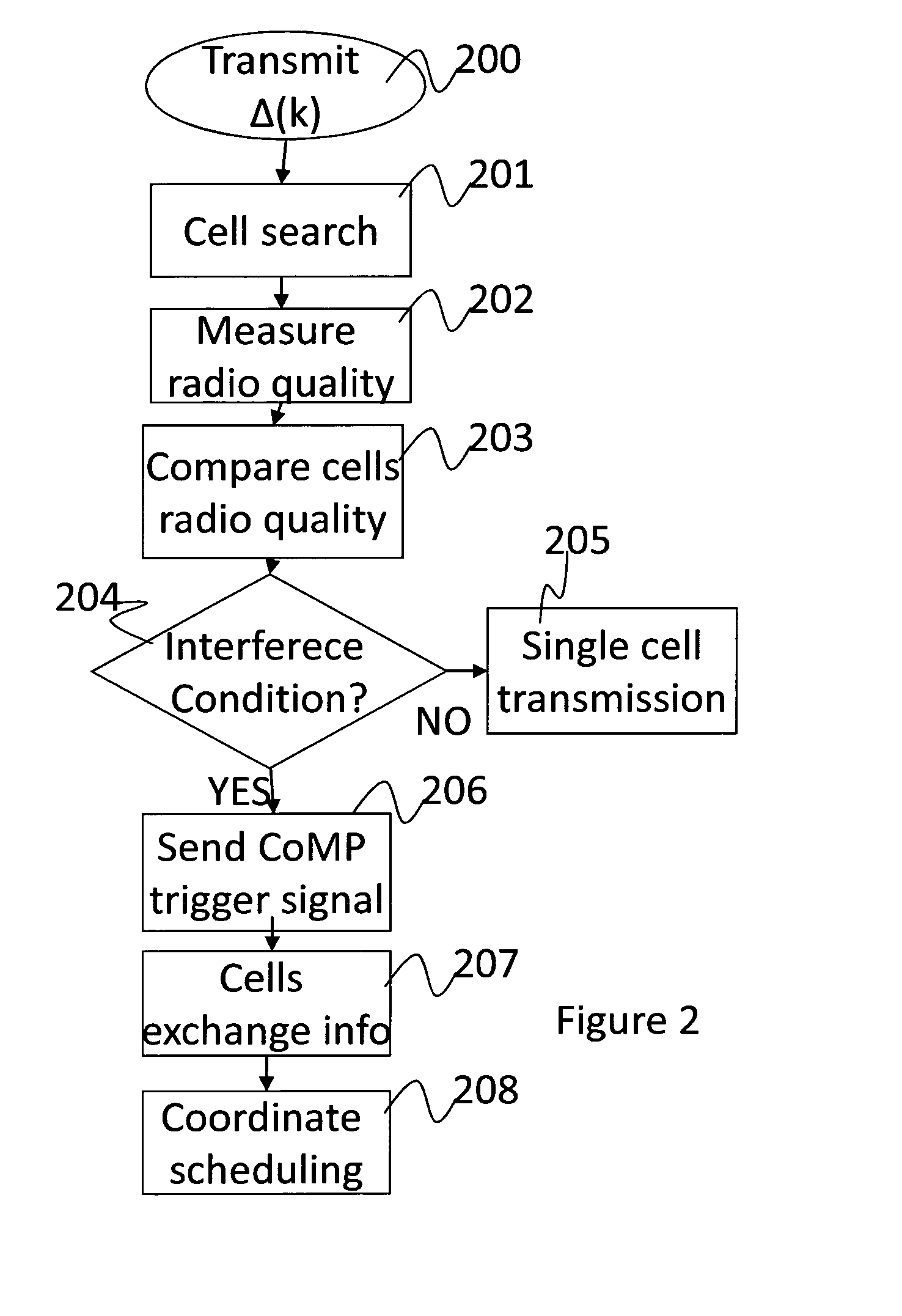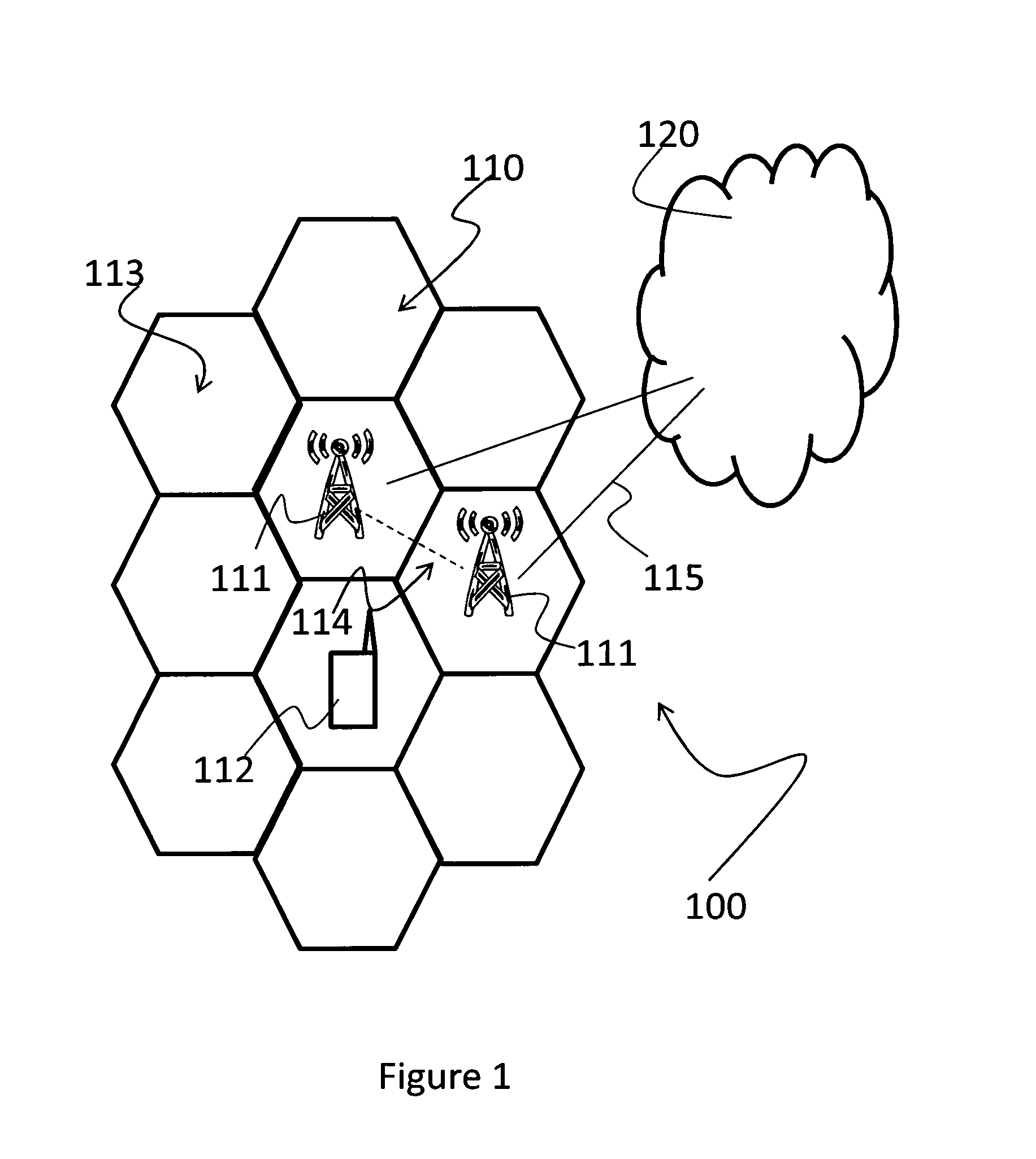Method for coordinated transmission in a plurality of cells of a wireless communication system
a wireless communication system and cell technology, applied in the field can solve the problems of limiting the spectrum efficiency increasing the complexity of wireless communication systems, and requiring coordination between cells, so as to maximize the diversity order or the degree of spatial multiplexing, maximize the effect of transmitting antennas and minimizing interferen
- Summary
- Abstract
- Description
- Claims
- Application Information
AI Technical Summary
Benefits of technology
Problems solved by technology
Method used
Image
Examples
first embodiment
[0074]In a first embodiment, UE 112 explicitly reports the CSI. In case of an explicit CSI reporting, a quantized version of the channel matrix Hcellj→UEi of the radio link between the interfering cell Ij and UE 112 is estimated and reported by UE 112 to the serving cell. This information is then conveyed (step 213) through the backhauling (i.e. the X2 interface) to the interfering cell.
[0075]The interfering cell Ij exploits the channel knowledge over the interfering link in order to reduce interference experienced by UE 112 (step 214). In particular, interfering cell Ij computes suitable precoding weights according to the multi-cell coordination scheme implemented in the network. For example in case of a pure multi-cell interference rejection scheme the precoding weights are calculated at the interfering cell Ij in order to place a null in the radiation diagram over the relevant direction towards UE 112. Example of algorithms suitable for this purpose are those based on the concept...
second embodiment
[0076]In a second embodiment, UE 112 reports an indicator correlated to the CSI; in this case UE implicitly reports the CSI. In case of implicit reporting, the CSI is preferably quantized by means of a codebook and the reported quantity is represented by an index, denoted as PMI (Precoding Matrix Index), of the best element to be picked up in the codebook. The implicit reporting reduces the CSI overhead at the price of a lower accuracy with respect to the explicit CSI reporting. Also in case of codebook based precoding the PMI selection done by the UE depends on the type of coordination scheme that is implemented in the network. In case of a pure interference rejection scheme the PMI is selected in order to minimize the power leakage between the interfering cell Ij and UE 112. In this case the useful data are transmitted to UE 112 only by the serving cell. In case of a joint transmission scheme the PMI is selected in order to maximize the channel gain between the interfering cell Ij...
third embodiment
[0088]In a third embodiment the value of the threshold Δi(k) is related to the load of the uplink radio interface where the CoMP signalling is transmitted. In general a lower value of the threshold is configured as the uplink load increases. In this respect it is also possible to imagine a centralized algorithm in the base station that jointly controls the value of the threshold as a function of the uplink load for all the users served by the cells which are under the control of the eNodeB. For example the algorithm may start to decrease the threshold as the uplink load increases by defining for each user a priority level related to the QoS class and the service type.
PUM
 Login to View More
Login to View More Abstract
Description
Claims
Application Information
 Login to View More
Login to View More - R&D
- Intellectual Property
- Life Sciences
- Materials
- Tech Scout
- Unparalleled Data Quality
- Higher Quality Content
- 60% Fewer Hallucinations
Browse by: Latest US Patents, China's latest patents, Technical Efficacy Thesaurus, Application Domain, Technology Topic, Popular Technical Reports.
© 2025 PatSnap. All rights reserved.Legal|Privacy policy|Modern Slavery Act Transparency Statement|Sitemap|About US| Contact US: help@patsnap.com



